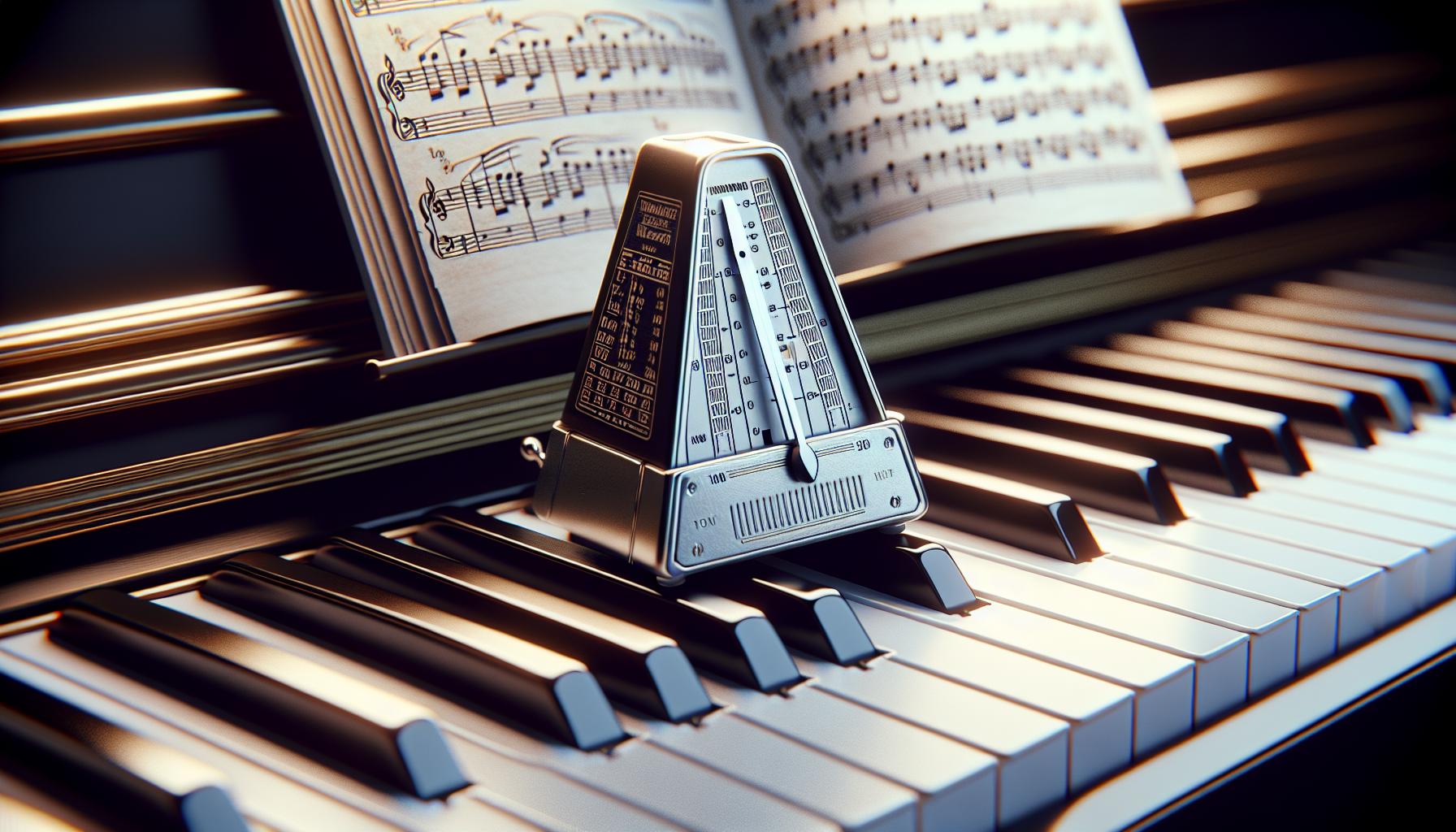When embarking on the exciting journey of learning piano, many budding musicians find themselves wondering if a metronome is a necessary companion. It's a valid question, especially in an era where digital tools and apps are at the forefront of educational resources.
A metronome, with its unwavering beat, seems like a straightforward tool, yet its impact on learning can be profound. It's not just about keeping time; it's about developing a relationship with rhythm that transcends the notes on the page.
So, do you really need a metronome to learn piano? Let's dive into the heart of the matter, exploring how this simple device can influence your musical journey.
Understanding the Role of a Metronome in Piano Learning
Using a metronome during piano practice can often feel like a debate among beginners and seasoned players alike. Some view it as an indispensable tool, while others might consider it an optional aid. However, understanding its role in piano learning reveals its undoubted value.
A metronome serves as a constant, unwavering friend, providing a steady pulse against which to measure one's rhythmic accuracy. In the realm of music, rhythm is as crucial as melody and harmony. It's the heartbeat of any piece, responsible for conveying emotion and structure. When learning to play the piano, rhythm can often be overshadowed by the challenge of hitting the right keys. This is where the metronome steps in, subtly guiding the learner to maintain a consistent tempo and improve their timing. It's not just about keeping up with the beats per minute; it's about developing a Deep Connection With the Rhythm that goes beyond the surface level of the music.
For beginners, a metronome can act as a sort of musical guardrail, keeping them on track as they navigate new compositions. The immediate feedback it provides helps in identifying timing issues that might not be apparent to the untrained ear. This real-time correction can significantly accelerate the learning process, making practice sessions more productive.
Advanced players, however, also find value in the metronome. It challenges them to maintain their tempo through complex passages, enhances their ability to play expressively without losing the beat, and aids in mastering the art of rubato—where the tempo is deliberately altered for expressive effect. Despite its seemingly rigid nature, a metronome can, paradoxically, aid in achieving greater musical expressiveness.
In today's digital age, metronomes have evolved beyond the traditional mechanical device ticking away on top of the piano. Digital metronomes and apps offer a wide range of features, from adjustable beats and volumes to complex rhythm patterns. This versatility not only makes the metronome more accessible but also more engaging for learners of all levels.
- Consistency:
Benefits of Using a Metronome for Practice

When diving into the world of piano learning, the question of whether to incorporate a metronome into practice sessions often arises. While some may view it as unnecessary, the benefits of using a metronome can significantly enhance the learning process.
First and foremost, a metronome serves as an unwavering rhythm keeper. For beginners, maintaining a consistent tempo can be a daunting task. The metronome stands as a reliable guide, ensuring that learners adhere to the specified beats per minute (BPM) for any piece. This constancy is crucial not only in developing a solid sense of timing but also in building the muscle memory needed for precise finger movements.
In addition to fostering rhythmical accuracy, practicing with a metronome also promotes tempo control, an essential skill for any musician. As players progress, they encounter compositions with varying tempos and rhythms. The ability to adjust and control one's pace according to the music's demands is what separates good musicians from great ones. The metronome, with its adjustable BPM settings, offers a practical way to practice this skill, allowing musicians to incrementally increase or decrease their speed while maintaining control and accuracy.
Another significant advantage is the improvement of expressive playing. Music isn't just about hitting the right notes at the right time; it's about conveying emotions and telling a story. Dynamic changes, crescendos, diminuendos, and rubato are techniques employed to add expression to a performance. A metronome can help players understand how these expressions fit within the framework of a steady rhythm, enabling them to experiment with timing and pacing while keeping the piece coherent.
For those aiming for technical mastery, the metronome is an invaluable tool. Technical exercises, such as scales, arpeggios, and chord progressions, benefit immensely from metronome use. These exercises, when practiced consistently with a metronome, can greatly improve finger dexterity and evenness in playing. Moreover, it allows learners to track their progress, as they can gradually increase the metronome speed while maintaining accuracy, a clear marker of improvement.
How a Metronome Improves Timing and Rhythm Skills

Learning to play the piano involves mastering the delicate balance of timing and rhythm. It's essential not just to hit the right notes but to hit them at the right time. That's where a metronome becomes an invaluable tool, ensuring that musicians, especially beginners, develop a keen sense of timing and rhythm that underpins all music.
A metronome, with its consistent clicks, serves as a precise guide for keeping time. Each click represents a beat, helping players measure the duration between notes and rests accurately. This heightened sense of timing ensures that music flows exactly as it's meant to, neither too fast nor too slow.
Developing Internal Metronome
One key benefit of practicing with a metronome is the development of an internal metronome. Over time, musicians begin to internalize the tempo, gradually relying less on the metronome and more on their innate ability to keep time. This skill is crucial, as it allows pianists to maintain a consistent pace, even in the absence of the metronome.
This skill development is critical for solo performances or when playing in a group where timing and synchronization with other musicians are pivotal. The ability to keep perfect time enhances the overall harmony of ensemble performances.
Training in Various Musical Genres
Different musical genres demand different tempo and rhythmic patterns. Jazz, with its syncopated rhythms, differs vastly from the even and structured beats of classical music. A metronome helps musicians adapt to these varying demands by allowing them to practice at the specific tempos required for different genres. This versatility is crucial for pianists who aspire to be proficient across various musical styles.
Improving Sight-Reading
Metronomes also play a significant role in improving sight-reading skills. Sight-reading requires musicians to play a piece of music they've never seen before with accuracy and proper timing. By practicing sight-reading with a metronome, pianists develop the ability to quickly decipher rhythm and tempo markings, making them more proficient readers of music.
Rhythmic Accuracy and Control
Finally, consistent practice with a metronome enhances rhythmic accuracy and control. This precision is essential for executing complex rhythms and transitions smoothly. Pianists learn to accentuate certain beats and play with dynamics within the tempo set by the metronome, leading to more expressive performances.
- **A metronome ensures accurate timing
Tips for Effective Metronome Practice Sessions

When embarking on the journey of metronome practice, it's crucial to approach it with a strategy in mind. Integrating a metronome into piano practice isn't just about playing along with clicks; it's about cultivating precision, discipline, and ultimately, musical freedom. To make the most of metronome practice sessions, follow these practical tips.
Start Slowly
One common misconception is the need to match the metronome's pace from the get-go. In reality, starting slowly allows for a much deeper understanding of the piece and ensures accuracy. By setting the metronome to a slower tempo than the target speed, pianists can hone their technique and gradually increase the tempo as their comfort and proficiency with the piece improve.
Break It Down
Attempting to tackle an entire piece at once can be overwhelming. Instead, break the piece into smaller, manageable sections. Focus on practicing these segments independently with the metronome ticking away. This approach not only makes practice more digestible but also enables detailed attention to rhythm and timing in challenging passages.
Use Different Settings
Modern metronomes offer a range of settings that can be leveraged to enhance practice sessions. For instance, setting the metronome to emphasize downbeats can help in mastering complex time signatures. Additionally, some digital metronomes allow for different sounds or volumes on beats, which can aid in emphasizing particular rhythmic patterns or syncopations.
Incorporate Dynamic Markings
While metronomes excel in teaching timing, they should not lead to monotonous, mechanical playing. Be mindful of the dynamics and expressive elements of the music. Even when playing with the metronome, make sure to incorporate crescendos, decrescendos, and other dynamic markings. This ensures that the emotional essence of the piece isn’t lost in the pursuit of rhythmic precision.
Record Your Sessions
Recording practice sessions can be enlightening. It provides an opportunity to listen back and assess timing, note accuracy, and overall musicality. With the metronome ticking in the background, it becomes easier to identify sections where the timing might falter or rush, providing clear targets for improvement.
Incorporating the Metronome into Your Piano Practice Routine

When embarking on the journey of learning piano, the question of whether a metronome is necessary often arises. While some may view it as merely a ticking device, its benefits in developing musicality and technical skills can't be overstated. The metronome, a tool that produces a consistent beat at various tempos, can be a pivotal part of a pianist's practice routine.
To start incorporating the metronome into piano practice, first understand its functions and settings. Most digital metronomes offer a variety of tempo markings, rhythms, and sometimes even different sound options. Getting familiar with these features will allow pianists to use the metronome more effectively during practice sessions.
Starting With Slow Tempos
One of the most effective ways to incorporate the metronome into piano practice is by beginning with slower tempos. This approach allows for a deeper understanding of the music's structure and nuances. It's crucial to:
- Focus on precision in finger movements and timing.
- Gradually increase the tempo as each section of the piece becomes more comfortable.
- Avoid jumping to faster tempos too quickly, as this can lead to sloppy technique and rhythm.
Breaking Down Pieces into Manageable Sections
Rather than attempting to play through an entire piece at full speed, break it down into smaller, manageable sections. This technique enables pianists to concentrate on mastering one part at a time, ensuring accuracy and consistency. Here are some tips:
- Use the metronome to maintain a steady pace while focusing on difficult passages.
- Practice each section separately, then gradually piece them together.
- Adjust the metronome settings as needed to accommodate different rhythmic patterns within the piece.
Utilizing Different Metronome Settings
Exploring different metronome settings can further enhance practice sessions. Some settings to consider include:
- Emphasizing Downbeats: Helps in maintaining the pulse, especially in pieces with complex rhythms.
- Varied Sounds: Some metronomes allow for different sounds or volumes on certain beats, aiding in the emphasis of strong versus weak beats.
- Adjust their playing to include soft (piano) and loud
Conclusion
Mastering the piano is a journey that requires patience, practice, and the right tools. A metronome, with its ability to guide musicians through complex rhythms and structures, proves to be an invaluable companion. By starting slow, breaking pieces down, and experimenting with settings, learners can significantly improve their musicality and technical skills. So whether you're a beginner or looking to refine your technique, embracing the metronome in your practice routine might just be the key to unlocking your full potential at the piano.
Harlan Kilstein began playing piano during covid with no piano background at all. He taught himself how to play learning what to do and what not to do.
Today he's an advanced intermediate player and can help you grow in your skills because he learned all this on his own.








